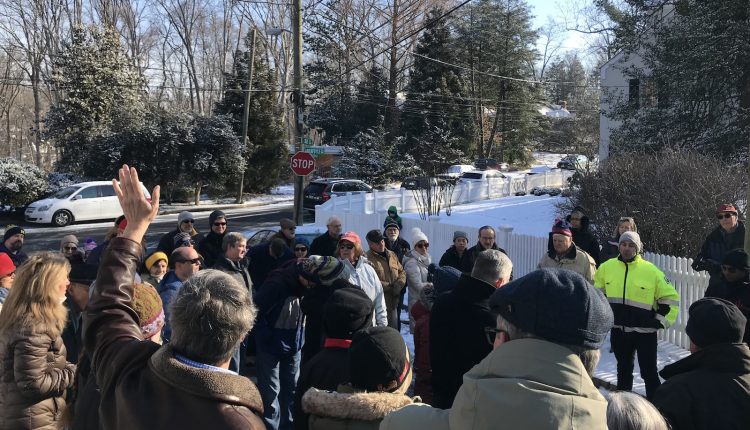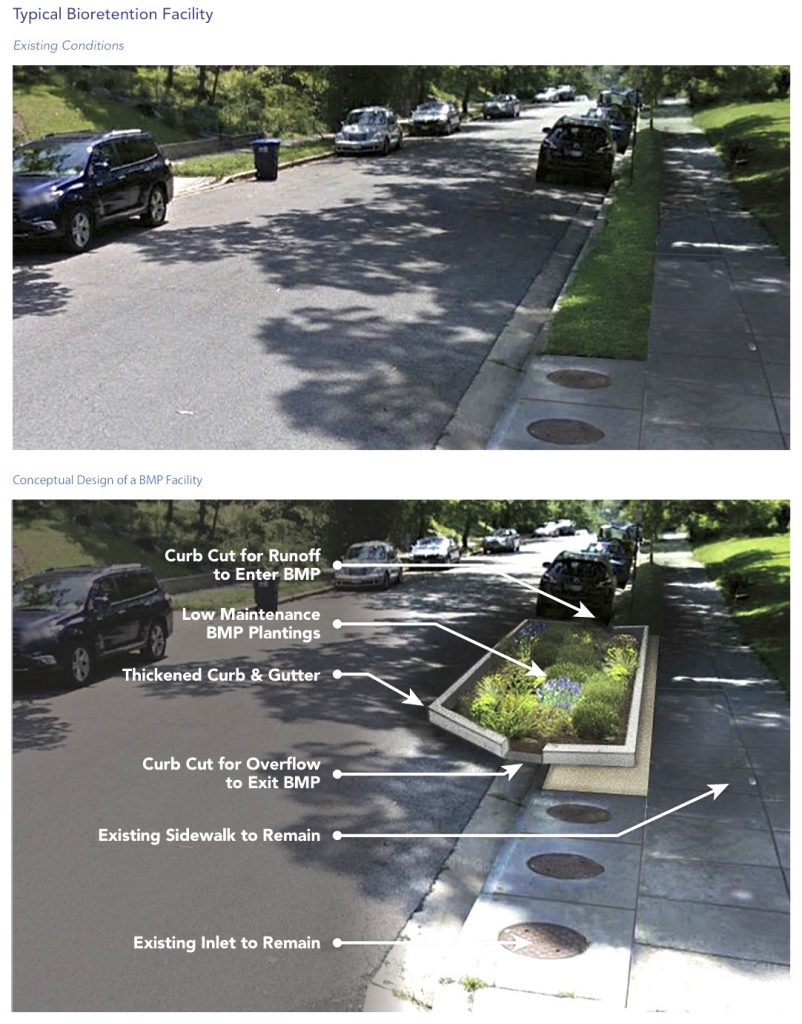
Next to Rock Creek Park, neighborhood resistance to District’s rain gardens on city streets
In a verdant Northwest neighborhood named after its woods, residents are vowing to resist the city’s efforts to add more greenage with over two dozen rain gardens on local streets.
As part of the District’s plan to clean waterways of pollution, engineers are installing “green infrastructure” able to capture stormwater throughout the city. The objective is simple: Collect rainwater at the source before it sloshes down asphalt roads, gathering toxins and eventually depositing the polluted mix into the Potomac and Anacostia rivers.
One environmental trouble spot is in Barnaby Woods, a northern section of DC’s Chevy Chase neighborhood adjacent to Rock Creek Park. Rainwater there flows down the neighborhood’s steep ridges and deposits into the creek, bringing along contaminants. For more than two years, the DC Department of Transportation has worked on a project to build 29 gardens in this area to collect stormwater before it has a chance to pollute the creek.

But opposition is strong in the neighborhood, where many residents believe these curb-out gardens would be too densely packed and create various traffic, parking and quality-of-life problems. Nineteen blocks would receive at least one garden, with some intersections getting three or four nearby.
“In a residential neighborhood, in fact adjacent to woods, where we have wildlife and plenty of yard and bushes and trees, this is not welcomed,” said Carolyn Cook, a resident and former advisory neighborhood commissioner. “In fact, it doesn’t beautify our neighborhood at all.”
On the frigid morning of Feb. 2 at Aberfoyle and 31st places NW, about 50 neighbors met with city officials outside a house that is slated to have two gardens installed in front of it.
Susan Greynolds, the owner of the single-family home and a real estate agent, was worried the gardens would remove parking spaces, a common objection among neighbors. She said the additions would tank the value of her home, which she has lived in for over 50 years and inherited from her parents.
“I’m begging you, this is my livelihood,” said Greynolds, her voice breaking. “You are taking money from me. This is my house.”
“I’m not exactly sure I would qualify this as suffering,” Jeff Marootian, director of the DDOT, replied moments later.
The Barnaby Woods project, which also includes installing permeable pavement in one alley, is part of an overall DDOT strategy across the city. The agency has recently completed four green infrastructure or permeable pavement projects, with three others under construction currently, according to DDOT spokesperson Lauren Stephens. The LeDroit Park neighborhood in Ward 1 and the Alger Park area in Ward 8 are among the sites where work continues.
Meanwhile, the DC Water and Sewer Authority is also building rain gardens as part of a federal agreement to reduce water runoff. After efforts to build permeable pavement were shelved in Georgetown, DC Water instead focused on nearby Burleith and Glover Park, according to a February 2017 article in The Current. Critics in historic Georgetown cited the impact on its tight alley system and limited on-street parking during construction and thereafter, though they also challenged DC Water’s estimates of the impact from runoff in the immediate area.
Neighbors to the north didn’t foresee the same impacts, and proved more receptive. Jackie Blumenthal, an advisory neighborhood commissioner in Glover Park, praised DC Water’s outreach for that recent project in her neighborhood, saying the agency notified each homeowner about permeable pavement and gardens being built.
“It went fairly smoothly,” she said.
Across the Anacostia River, Antawan Holmes, chair of Advisory Neighborhood Commission 7C, said the Deanwood neighborhood had no complaints from recent projects at recreation centers and would like to see more gardens and permeable pavement to reduce flooding.
In Barnaby Woods, the proposed gardens range from 25 to 80 feet in length, with most around 45 feet. Selected plantings are meant to retain and filter the rainwater, and underground piping can store excess water.
DDOT first presented the plans to the community in February 2017. The city showed 70 potential sites at that meeting, although 29 gardens were ultimately chosen. Marootian said the city plans to begin construction in the spring, with the potential for minor adjustments to plans before then. Another community meeting is scheduled Wednesday from 7 to 9 p.m. at the Chevy Chase Community Center.
Critics said the city did not sufficiently inform the community about the plans. One meeting last year, for example, was scheduled on Yom Kippur. Marootian contended there’s never a perfect time for a public meeting, and noted that multiple presentations were held.
After his office was “inundated with calls and emails,” Ward 4 DC Council member Brandon Todd wrote to Marootian on Nov. 4 that “outreach efforts to-date have been insufficient.” He echoed the chair of ANC 3/4G in seeking analyses about traffic and the effectiveness of such gardens in reducing runoff.
In an email to The DC Line this week, a Todd spokesperson wrote: “It is critical that infrastructure changes of this permanent and significant nature have the support of immediately adjacent neighbors and the community as a whole.”
Todd met with dozens of neighbors on Monday night for over an hour. Van Hazen Street resident Michael Behm — who said two gardens are planned for his street — is one of several neighbors hoping to get Todd to oppose the project.
“DDOT picked the off-the-shelf solution to stormwater diversion and ignored the more creative and maybe more innovative strategies,” said Behm, a lobbyist and consultant in his day job.
Some residents said the District should have reached out to each homeowner personally.
“We’re going to be known as the neighborhood with the ugly pits everywhere,” resident Elizabeth Patton said at the Feb. 2 community meeting.
DDOT officials said the neighborhood’s soil makes gardens the most suitable type of green infrastructure for Barnaby Woods. Some residents had suggested permeable pavement as an alternative, but the agency says it’s not a viable option for most of the area.
Officials took into account slope, the volume of drainage area, and impacts on utility lines when choosing the locations for the gardens, said Julie Pike, an engineer with DDOT.
Ward 3 Council member Mary Cheh, whose Committee on Transportation and the Environment has oversight over DDOT, said she plans to ask the agency during budget hearings about whether the city regularly keeps rain gardens in good condition, a concern for some. The city has sought to assure residents that it will maintain the installations, but many are skeptical and worry that they’ll ultimately have to bear the burden and cost themselves.
“The government has control over the public space, but the homeowner at the same time has to take care of the public space,” Cheh said. “If it happens to be in front of your house, you’re expected to keep it maintained.”


Marootian for mayor!
1-As A retired RanR iN n the health care field, I adamantly oppose these so-called “swales”.
These seemingly harmless “gardens”??? Are not properly described: in reality They Aare succinctly- TOXIC FILTRATION PITS”. Designed to trap & deposit bacteria, gasoline, fertilizers, animal waste, etc. in front of our homes for deer, raccoon, rats etc. to forage thru.
This s a health hazard to a neighborhood whose water pipes.are 80 years old.. Address this I as infrastructure problem 1st before starting this future environmental problem.
Barnaby St & Wothngton St. NWwe’re scheduled for change to my corner homewhich had 8o yr old pipes to be replaced if needed and connected to the street Main waterline. After a year of drilling on y corner, DC Gov’t told me with approv 15-20ft to connect to the new line. I WAS NOT GOING TO BE CONNECTED.
2-Another problem to me home DDOT CAUUSED AND HAS NOT FIXED IS LANd-SHIFT FROM 8 yrs. ago putting a new sidewalk on my corner lot, causing me erosion problems.
3- A serial DEVELOPER HAS BUILT NEXT TO MY CORNER HOME , a 4 story Mc Mansion the whole length of my lot-WESTERN EXPOSURE Now I have no Sun, cloudy days with environmental change, my backyard view it off- woods. grass is turning to moss, and basement flooding.
It is my understanding, Developers can DO THIS UDER RULES WRITTEN BY THEM UNER …” RIGHT OF WAY”.
At what point, I ask, is DC Government held accountable
I am 88 years old . A55 year DC resident. Low Incpme resident.
DDOT replaced part of the street on our block (2nd and Ingraham NW) with (a more) permeable pavement, and a couple alleys near us. Around the corner are several of the new rain gardens; I wish one could be installed in front of our house, too — native plants adapted to the climate, less runoff, and no mowing. The new ones will look better once the plants have a chance to grow in, I predict.
These “drip ‘gardens'” do not work. DDOT has done nothing to maintain the ones near Lafayette School.
Nothing + Nothing = Nothing
I wish we got this kind of attention in downtown DC in Mount Vernon Square Historic Neighborhood. Instead DC lets developers cut down canopy trees (for which they lay $3,000 for the city to plant a sapling somewhere else in the city) and infill neighbors’ backyards with 3-story condo buildings and parking lots, none of it green or permeable, making our neighborhood more prone to flooding and overwhelming our drains and sewers.